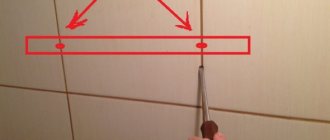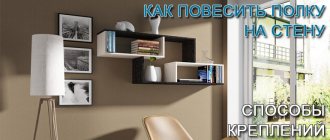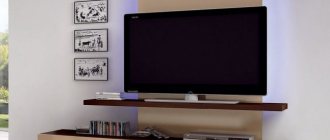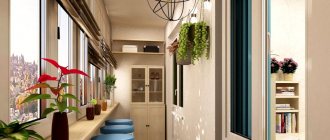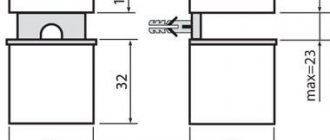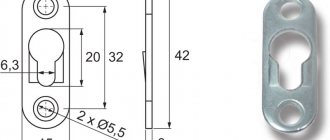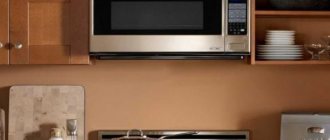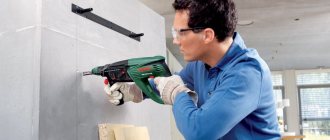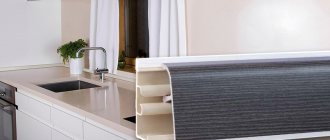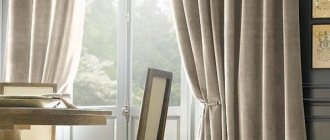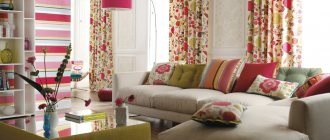Hi all! Creating a beautiful and practical interior in a frame house, in a country house or in an ordinary high-rise building often becomes the task of the immediate home owner. One of the pressing issues is how to hang a shelf on the wall.
This procedure may seem extremely simple and mundane. But not everyone knows how to act so that the fasteners are not visible, or what to do correctly if the walls are made of PVC, that is, of plastic panels, brick, shingles, lining and other common materials.
Today I will try to answer key questions, talk about the features of installing shelves and existing installation methods. You will get some answers from the video. And if you still have questions, you can always ask them in the comments.
Types of shelves
Basically, shelves are divided by design, methods of fastening and materials of manufacture. The most common types are the following:
- Classic shelves. Most often you can find this type of shelf in stores, because it is easy to install and reliable;
- Shelves with hidden fasteners. Unlike ordinary shelves, these are mounted on the wall using special fittings that are invisible;
- Floor structures. They are otherwise called shelving, and some believe that they are a type of cabinet. But racks differ from them in the absence of doors, and sometimes even a back wall. Such designs look light and do not clutter up the space, so they are especially relevant in the minimalist style and in small rooms. Also, the rack is inferior to the cabinet in terms of shelf depth.
The installation method is influenced not only by the type of structure, but also by the material of manufacture. In addition, the quality of the shelves, functionality and their appearance depend on it. Some styles require special furniture made from natural materials. For example, a plastic shelving would be inappropriate in Provence - only wood is used here. But for a loft or hi-tech it’s worth looking for metal shelves.
The shelves are made from:
- Tree. These can be either expensive species, or chipboard, MDF, etc.
- Metal. Usually the frame is made of it, but some shelf models can be completely metal.
- Glass. Glass shelves can often be found in a bathroom or shelving design. It can be matte or transparent.
- Plastic. The cheapest type of shelves, which is not durable or high quality. Plastic shelves are hung mainly in the children's room, in the kitchen or in the bathroom.
Useful tips
Even if you think that you don’t know how to hang a shelf correctly, you shouldn’t immediately call a professional. All you need to do is show a little effort and diligence, and you can easily get the job done. If, for example, you also need a shelving unit hung in the closet, then you can first practice on it, and then move on to working in rooms where there is finishing.
In addition, the greater the planned load on the fixed rack, the stronger the fasteners should be used. After all, over time, they may weaken, and the shelf will fall with all its contents. And this is extremely undesirable. Therefore, it is not recommended to skimp on bolts, as this can have negative consequences.
DIY apartment renovation
or wall cabinet correctly How to hang a shelf in a bathroom where the walls are finished with ceramic tiles? How to hang a shelf on drywall, the main qualities of which are not strength? Similar questions arise quite often. Although there is no difficulty here. After reading this review, you will see for yourself and can easily hang any shelf on the wall with your own hands.
What to consider when installing shelves
Before hanging a shelf, you need to pay attention to some installation nuances:
- Approximately determine how much load will be placed on the shelf.
- What will the shelf be used for?
- What type of fastening is required?
The most important thing here is the load. The type of fastener, installation method and location of the shelf depend on it. Large wall shelves require much more secure mounting than small plastic decorative shelves. Another feature is the purpose of the shelf. It should be located at a convenient height so that each family member can easily get the necessary thing. If you are equipping a home library, those books that are rarely read can be placed on high hanging shelves. But it is better to store your favorite literature in a rack.
Consider shelving as a way to zone a room. This technique is relevant in studio apartments, where you need to divide the space into several work areas. Shelving easily copes with this and can separate the kitchen from the living room, the bedroom from the nursery and any other areas.
In a children's room, the height of the shelves is responsible not only for convenience, but also for the safety of the child. They should be a little taller than his height, but not too low, because the baby is growing quickly. The most practical option is a small floor rack. Place your child's favorite toys on the bottom shelves so that he can easily reach them, and on the top - what he uses least often.
Preparing to install shelves
Before drilling, you need to know exactly where the wires are laid so as not to accidentally cut off the power to the wall. This is not always easy to find out, so if you do not have a wiring diagram in your apartment, purchase a special hidden wiring detector. Make sure that the chosen mounting method is acceptable and that the load exerted by the shelf on the wall is moderate. After this, you need to mark the attachment points. This can be done in different ways: either pre-fix the hinges, or attach the shelf to the wall and mark the places for them. The first option is preferable, as it is more accurate and convenient.
Be sure to use a level when working - it will help track distortions and unevenness of the wall.
Necessary materials
For wall shelves you can use a variety of materials:
- GKL. Designers often use plasterboard in interior design, especially if shelves made of this material are assigned one of the main places in the room.
- Tree. Most often used for balcony shelves. Working with it is not difficult, and its mass is small. When used correctly, these shelves can last a very long time.
- Chipboard or chipboard. Moisture-resistant material, withstands temperature changes, wear-resistant.
- Glass. Very common in use. Glass shelves look very fashionable.
- Plastic. The publicly available material, since it is inexpensive, is not susceptible to mold.
- Metal. When working with it, you will definitely need a welding machine.
Then screws are screwed in to a sufficient depth and hinges are placed on them.
If necessary, we make adjustments.
Tools for working with wall shelves
To hang the shelf, you will need the following tools:
- Drill. Its type depends on the material in which holes need to be drilled. If it is foam concrete, drywall and similar surfaces, a hand drill will do just fine. When working with a concrete wall, you cannot do without a hammer drill.
- Drills and bits. The wall may be stronger than expected, so having a set of extra drill bits on hand can be very helpful.
- Level. An indispensable tool designed to check the wall for distortions and unevenness.
- Screwdriver. Using a screwdriver will make the shelf installation process faster and easier.
- Pencil, ruler and other small items.
Rules for performing work
Like any other work related to the installation of furniture, repairs, or the use of unsafe tools, the installation of shelves and wall cabinets requires following certain rules and sequence of actions. This is necessary to ensure that the installation process does not bring troubles and inconveniences, and also to ensure that the product serves its intended purpose for a long time.
Before installing elements in the kitchen, study the rules and recommendations from experts.
Safety precautions when installing shelves
To avoid injury and damage, you must strictly follow safety precautions. Before starting installation, be sure to:
- Wear gloves, safety glasses and a mask.
- Check the power tool: there should be no mechanical damage. Before you start drilling into the walls, check if it works well.
- Make sure that there is no electrical wiring in the place where you plan to hang the shelf.
- The workplace must be comfortably equipped. Remove all objects that may interfere.
Features of hidden shelf fastenings
Installing a shelf using a hidden suspension has a number of features and differs from conventional installation:
- Consider the wall material. Shelves with hidden fastenings are not recommended to be hung on walls covered with plasterboard. If the surface is brick, its thickness should be more than 25 cm, and if it is concrete, it should be at least 10 cm.
- Shelf thickness. It should be in the range from 3 to 6 cm, the best option is 4-5 cm.
- Type of fastener. Choose pins whose length is equal to twice the width of the shelf. Also pay attention to the diameter - it should be more than 10 cm.
- Load. Each type of shelf has its own weight restrictions that need to be taken into account. This can be found out upon purchase.
What fasteners to use for glass furniture
Modern models consist of many glass and glossy panels. To fix them, special types of fasteners are used. Silicone and rubber gaskets help reduce friction.
They prevent damage to the glass panel during the assembly process. Most of the parts are glued with a special adhesive. The fittings consist of lightweight metals. Thanks to this, all the details are in harmony with each other. Hidden furniture fasteners are used here.
For larger models, corners, hinges and locks are used. Thin screws and self-tapping screws with plastic attachments help secure these elements.
How to hang a shelf if the wall is made of plasterboard
Material such as drywall is now in great demand. Installing shelves on walls sheathed with it differs from traditional methods, so special fastening systems designed for drywall can be found on sale. They greatly simplify the process and make the fastening reliable.
A shelf on a plasterboard wall can be hung in different ways:
- Special fastening systems. They are called molly or butterfly screws. Their use is allowed if a large load on the shelf is not expected.
- Power frame. Plasterboard sheets are installed on it.
- To Wall. Sometimes drywall may not adhere tightly to the wall. In this case, the shelf can be hung directly on the wall.
Mounts without visible fasteners
Many people now choose fastenings without visible fasteners, since this option involves completely invisible fixing of the shelf on the wall , without unnecessary elements. It is the reluctance to see additional elements on the walls for one reason or another that drives the owners of shelves and apartments to choose this option.
Brackets for mounting shelves in the wall
There are three options to secure the shelf to the wall so that the fasteners are not visible.
- Using small hanging loops. In this case, the fixation is carried out using small loops that are attached to the back of the shelf and remain almost invisible. They are put on screws screwed into the wall in advance. In this case, it is important to apply the markings correctly and hang the shelf evenly. This type of fastener is not suitable for products that do not have a frame as such, that is, shelves consisting of one board. Otherwise, the shelf will not hold up.
DIY zigzag shelf made of chipboard - Using metal pins. This option is just right for shelves consisting of one board. You need to fix long metal pins in the wall, and drill holes of a suitable depth from the end of the shelf and put the product on the pins in the wall. The shelf is supported by the fact that it rests on these metal elements. It can support quite a lot of weight.
Fastening with metal pins - Using a long wooden block. This method of fixation cannot be called completely invisible, since a block of square or rectangular cross-section is used as a kind of base for the shelf. It is fixed on the wall, and a shelf is attached to it in the desired position. Or it can be fixed on pins coming out of the bar. This option is inconspicuous, since if you choose a block of the same color and texture as the shelf itself, it will not be noticeable. Rather, it will look like some element of the product itself. To fix the shelf on the block, hidden fittings such as pins or pins are used, onto which the shelf is placed.
Hidden fastening of shelves to the wall without visible fasteners
The most reliable option for fixing the shelf is with metal pins, as this will provide the ability to seriously load the shelf. Moreover, this is the most inconspicuous option, even in comparison with other methods related to secret ones.
Attaching a shelf to a concrete wall
Concrete walls are the strongest and most reliable. They can withstand almost any load, but installing shelves here is correspondingly more difficult. You can’t do without a hammer drill and drills designed for concrete surfaces.
If you don't have a hammer drill, you can try making holes using an impact drill. But this is not the best way - most likely, its power will not be enough.
Shelf holder in the closet: care and operation
As such, there are no special rules relating exclusively to the care of fasteners. Unless the plastic corners and tension sleeves are kept clean. The mode of operation is more important here. For example, a connection with Euroscrews does not tolerate loads in a perpendicular plane.
There are no special requirements for the care of fasteners. Minifixes, conical ties and especially rafixes have a greater degree of resistance. The weakest point of such fasteners is the cutouts for the pin. Therefore, you should not load the shelves more than usual. In addition, it is advisable not to allow excess humidity in the room, as this does not have the best effect on the mechanical properties of wood.
If the shelf is properly attached, it will last a very long time. Based on the large selection of available fasteners and auxiliary accessories, solving problems with installing a new shelf or fixing a broken one should not present much difficulty. Moreover, using original fastenings for shelves in the closet, you can try to optimize the internal space so that everything you might need fits there.
How to hang heavy shelves
When choosing a shelf, you must know exactly what load is expected. The size of the load-bearing surface, as well as the method of fastening, depend on the weight of the items stored on the shelf. If you plan to place large items on it, for example, pillows, blankets and bed linen, choose long shelves about 100-120 cm.
When storing heavy items, the maximum shelf length is 85 cm. Vertical support may also be required to prevent sagging. Place heavy objects so that their weight rests on supports. For a home library, it is better to give preference to shelves about half a meter long. This is not only convenient, because you don’t have to reach high, but also reliable - the shelves in the rack have more support points, and therefore are more practical than wall-mounted ones.
When installing shelves for heavy objects, you need to take into account the thickness of the wall, the permissible weight and the number of places for fasteners. The shelf can simply be hung on the wall without additional power frames, but it is still worth using them. There is especially no need to neglect additional methods of fastening in the case when the shelves are hung above a sofa or bed - there is a possibility that they will not withstand the load.
The structure of the wall also affects the fastening elements. For example, a shelf can be attached to a foam block using special dowels, dowel nails or an anchor.
Common mistakes when installing shelves
Inexperienced people may hang the shelf incorrectly, and errors will appear after installation is completed. To avoid this, remember that:
- The length of the drilled hole should be slightly longer than the length of the screw.
- Foam concrete is a rather low-density material, so ordinary hardware cannot be used for fastening. They will not stick to the wall, moreover, they can destroy it. Plastic dowels, metal fasteners and chemical anchors should be used.
- If the load vector is directed perpendicular to the axis of the drywall sheet, the wall will simply break. To avoid this, special dowels for drywall are used: Driva dowel, butterfly dowel and Molly anchor.
- Heavy structures are attached exclusively to load-bearing walls.
- You need to carefully select fasteners that will match the type of shelf and be suitable for the wall material.
Required Tools
The tools you will need are: a level, a drill, or better yet a hammer drill, a screwdriver, dowels, self-tapping screws, a jigsaw, wood glue, a fastening set, a set of drills, a pencil, a hammer, and a wrench for anchor bolts.
If you use metal rods, you need to remember that the diameter of the fastening element should be 10-12.
Upon completion of all stages of work, we attach the shelf.
